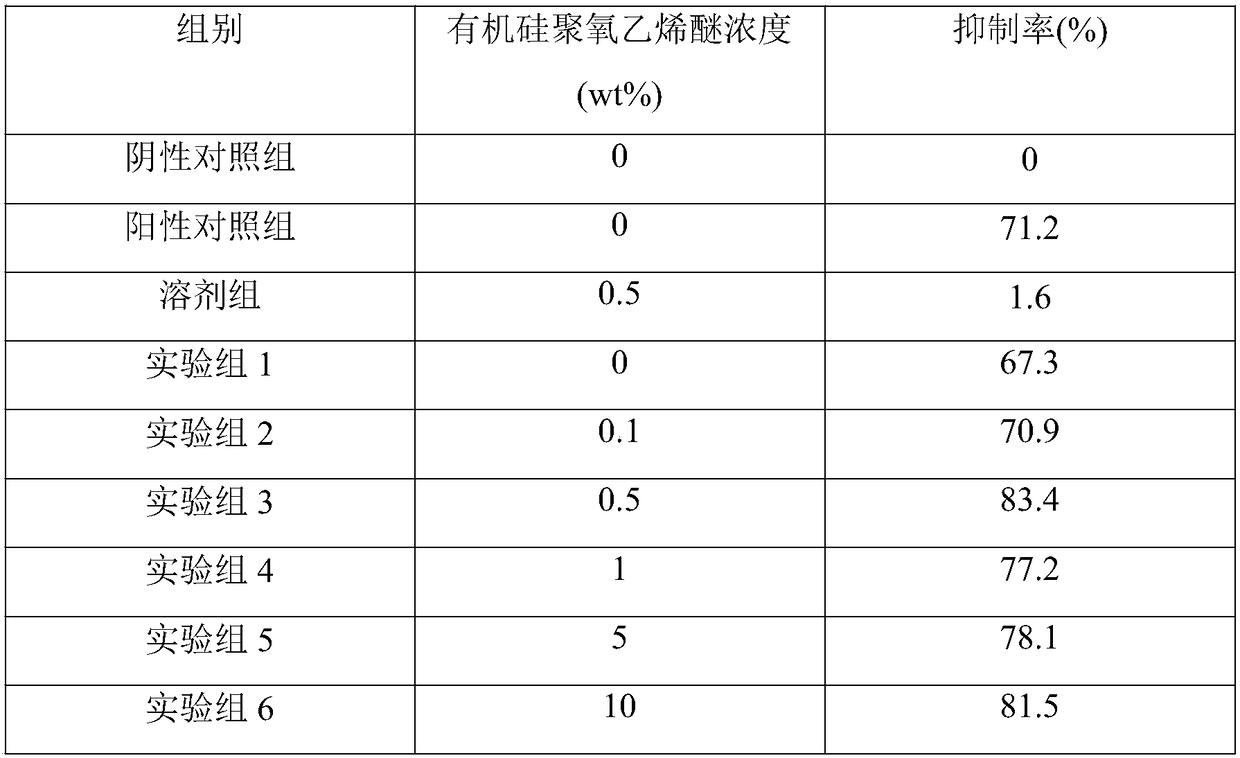Method for treating rice brown spot disease on basis of capsaicin
A technology of flax leaf spot and capsaicin, applied in botany equipment and methods, chemicals for biological control, animal repellants, etc., can solve the problems of poor control effect, large environmental pollution, and high investment. Achieve the effect of eliminating losses, good control effect and quick effect
- Summary
- Abstract
- Description
- Claims
- Application Information
AI Technical Summary
Problems solved by technology
Method used
Image
Examples
Embodiment 1
[0056] Embodiment 1: The preferred concentration of organosilicon polyoxyethylene ether in the treatment of rice flax leaf spot
[0057] 1. To prepare capsaicin solution, the steps are as follows:
[0058] (1) Accurately weigh 10 mg of capsaicin crystals and 2 mL of analytically pure DMSO to fully shake and dissolve;
[0059] (2) Accurately measure 999mL double-distilled water, add the above-mentioned capsaicin DMSO solution into double-distilled water and fully stir and mix;
[0060] (3) Accurately weigh the silicone polyoxyethylene ether respectively, heat the solution and the silicone polyoxyethylene ether in step (2) to 55° C., and use a magnetic stirrer to stir the silicone polyoxyethylene ether into the step ( 2) In the solution in , the stirring speed is 800rpm, so that the concentration of silicone polyoxyethylene ether is 0, 0.1, 0.5, 1, 5, 10% (wt);
[0061] (4) After the silicone polyoxyethylene ether is completely added into the solution, keep the temperature at ...
Embodiment 2
[0074] Embodiment 2: the optimization of capsaicin solution spray times and frequency
[0075] The specific operation steps are as follows:
[0076] 1. To prepare capsaicin solution, the steps are as follows:
[0077] (1) Accurately weigh 10 mg of capsaicin crystals and 2 mL of analytically pure DMSO to fully shake and dissolve;
[0078] (2) Accurately measure 999mL double-distilled water, add the above-mentioned capsaicin DMSO solution into double-distilled water and fully stir and mix;
[0079] (3) Weigh 5g of silicone polyoxyethylene ether, heat the solution and silicone polyoxyethylene ether in step (2) to 55°C, and use a magnetic stirrer to stir the silicone polyoxyethylene ether into the step ( 2) In the solution in , the stirring speed is 800rpm, so that the concentration of silicone polyoxyethylene ether is 0.5% (wt);
[0080] (4) After the silicone polyoxyethylene ether is completely added into the solution, keep the temperature at 55°C, continue to stir at the sam...
Embodiment 3
[0093] Embodiment 3: Capsaicin is tested and the result is as follows to the therapeutic effect of rice flax leaf spot:
[0094] Follow the steps below to implement:
[0095] 1. To prepare capsaicin solution, the steps are as follows:
[0096] (1) Accurately weigh 3, 5, 10, and 15 mg of capsaicin crystals respectively, and fully shake and dissolve 2 mL of analytically pure DMSO;
[0097] (2) Accurately measure 999mL double-distilled water, add the above-mentioned capsaicin DMSO solution into double-distilled water and fully stir and mix;
[0098] (3) Weigh 5g of silicone polyoxyethylene ether, heat the solution and silicone polyoxyethylene ether in step (2) to 55°C, and use a magnetic stirrer to stir the silicone polyoxyethylene ether into the step ( 2) In the solution in , the stirring speed is 800rpm, so that the concentration of silicone polyoxyethylene ether is 0.5% (wt);
[0099] (4) After the silicone polyoxyethylene ether is completely added into the solution, keep t...
PUM
| Property | Measurement | Unit |
|---|---|---|
| Concentration | aaaaa | aaaaa |
| Concentration | aaaaa | aaaaa |
Abstract
Description
Claims
Application Information
 Login to View More
Login to View More - R&D
- Intellectual Property
- Life Sciences
- Materials
- Tech Scout
- Unparalleled Data Quality
- Higher Quality Content
- 60% Fewer Hallucinations
Browse by: Latest US Patents, China's latest patents, Technical Efficacy Thesaurus, Application Domain, Technology Topic, Popular Technical Reports.
© 2025 PatSnap. All rights reserved.Legal|Privacy policy|Modern Slavery Act Transparency Statement|Sitemap|About US| Contact US: help@patsnap.com



